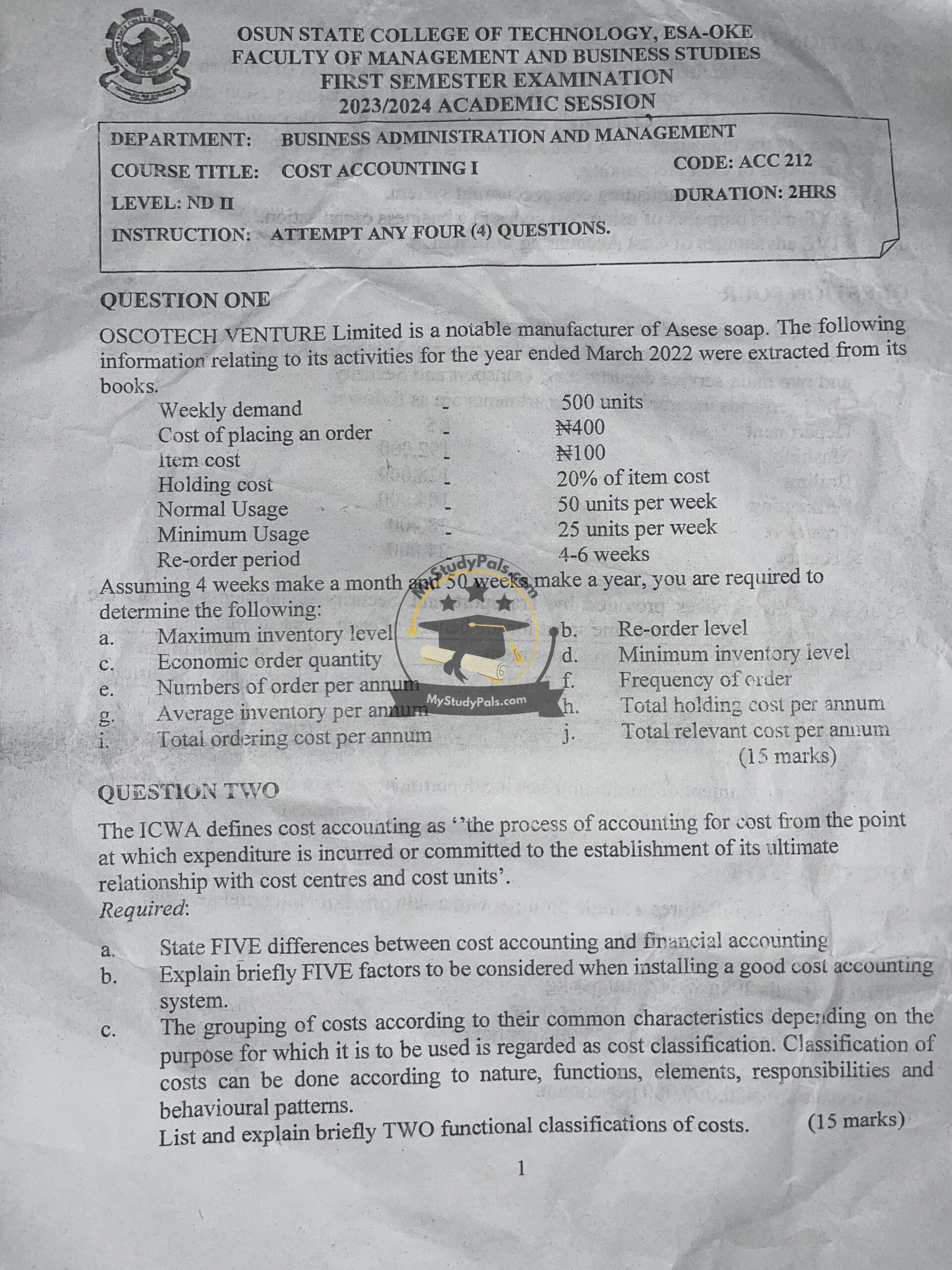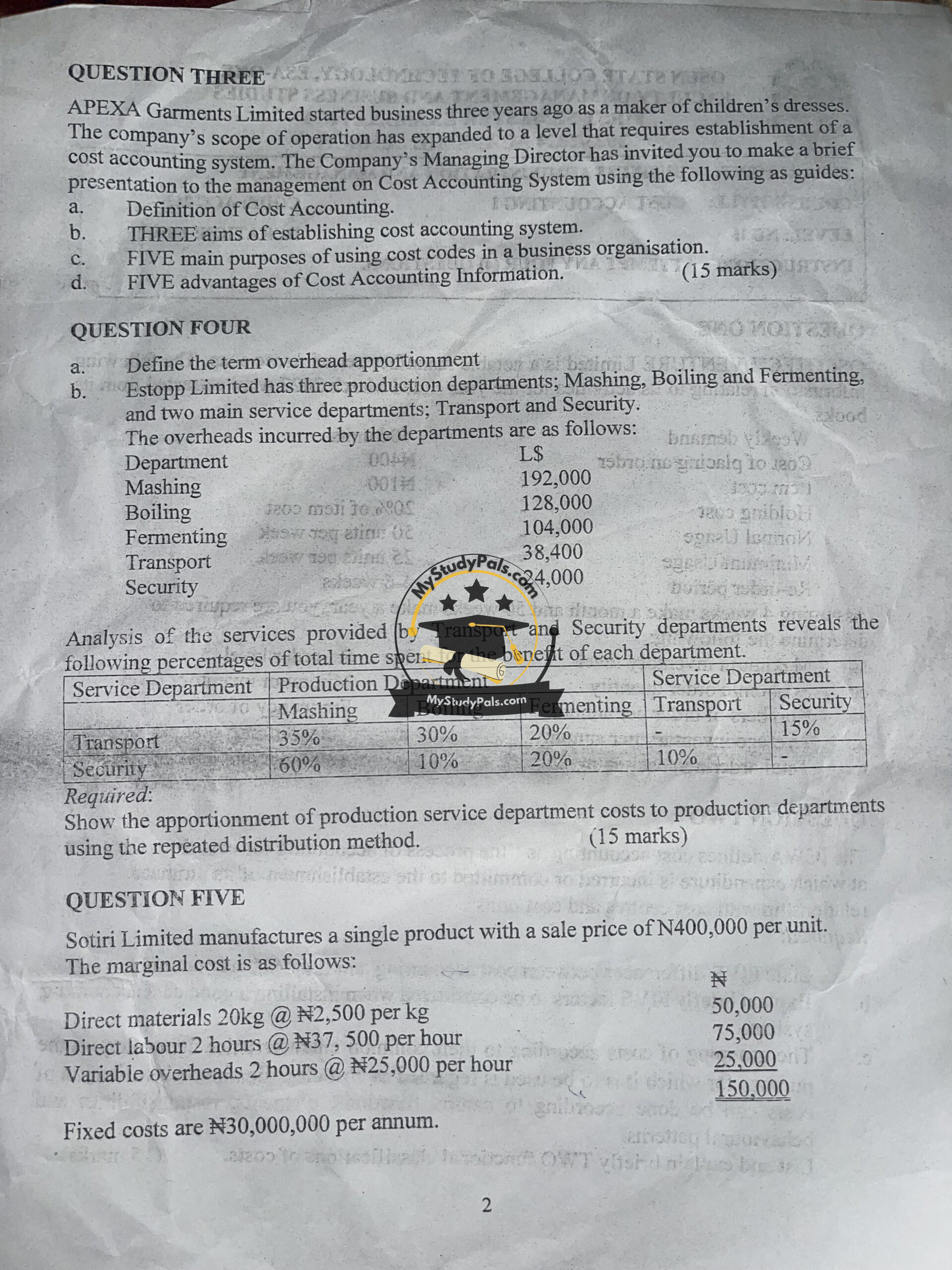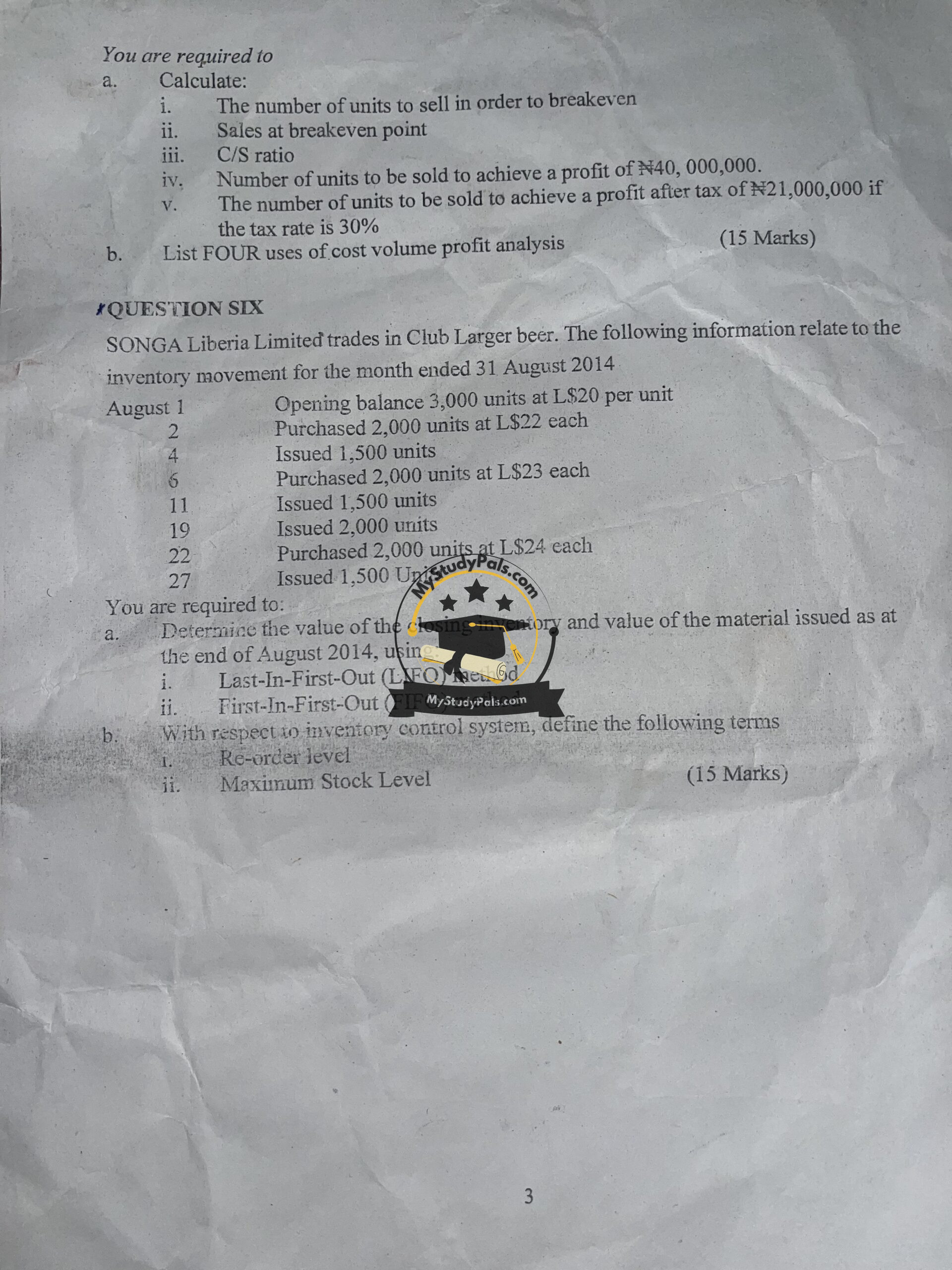ANSWER
Here are the answers to your exam questions:
Question 1:
a. Maximum Inventory Level
Maximum Inventory Level=Reorder Level+Economic Order Quantity−(Minimum Usage × Minimum Reorder Period)\text{Maximum Inventory Level} = \text{Reorder Level} + \text{Economic Order Quantity} – \text{(Minimum Usage × Minimum Reorder Period)}
b. Economic Order Quantity (EOQ)
EOQ=2DSHEOQ = \sqrt{\frac{2DS}{H}}
where:
- DD = Annual Demand = 500×50=25,000500 \times 50 = 25,000 units
- SS = Cost of Placing an Order = ₦400
- HH = Holding Cost per Unit = 20%20\% of ₦100 = ₦20
EOQ=2×25,000×40020=1,000,000=1,000 unitsEOQ = \sqrt{\frac{2 \times 25,000 \times 400}{20}} = \sqrt{1,000,000} = 1,000 \text{ units}
c. Number of Orders per Annum
Number of Orders=Annual DemandEOQ=25,0001,000=25 orders\text{Number of Orders} = \frac{\text{Annual Demand}}{\text{EOQ}} = \frac{25,000}{1,000} = 25 \text{ orders}
d. Minimum Inventory Level
Minimum Inventory Level=(Minimum Usage×Maximum Reorder Period)\text{Minimum Inventory Level} = (\text{Minimum Usage} \times \text{Maximum Reorder Period}) =25×6=150 units= 25 \times 6 = 150 \text{ units}
e. Frequency of Order
Frequency=Number of OrdersWeeks per Year=2550=0.5 (every 2 weeks)\text{Frequency} = \frac{\text{Number of Orders}}{\text{Weeks per Year}} = \frac{25}{50} = 0.5 \text{ (every 2 weeks)}
f. Average Inventory Per Annum
Average Inventory=EOQ2+Safety Stock\text{Average Inventory} = \frac{EOQ}{2} + \text{Safety Stock} =1,0002+150=500+150=650 units= \frac{1,000}{2} + 150 = 500 + 150 = 650 \text{ units}
g. Total Holding Cost Per Annum
Total Holding Cost=Average Inventory×H\text{Total Holding Cost} = \text{Average Inventory} \times H =650×20=₦13,000= 650 \times 20 = ₦13,000
h. Total Ordering Cost Per Annum
Total Ordering Cost=Number of Orders×Cost per Order\text{Total Ordering Cost} = \text{Number of Orders} \times \text{Cost per Order} =25×400=₦10,000= 25 \times 400 = ₦10,000
i. Total Relevant Cost Per Annum
Total Relevant Cost=Total Holding Cost+Total Ordering Cost\text{Total Relevant Cost} = \text{Total Holding Cost} + \text{Total Ordering Cost} =₦13,000+₦10,000=₦23,000= ₦13,000 + ₦10,000 = ₦23,000
Question 2:
a. Five Differences Between Cost Accounting and Financial Accounting
- Purpose: Cost accounting is for internal decision-making, while financial accounting is for external reporting.
- Users: Cost accounting is used by managers, while financial accounting is used by shareholders, creditors, etc.
- Legal Requirement: Cost accounting is not mandatory, while financial accounting is legally required.
- Time Focus: Cost accounting focuses on present and future costs, while financial accounting records past transactions.
- Reporting Format: Cost accounting reports are flexible, while financial accounting follows strict standards.
b. Five Factors to Consider When Installing a Cost Accounting System
- Nature of Business
- Objectives of the System
- Cost of Installation
- Capabilities of the Staff
- Integration with Other Systems
c. Two Functional Classifications of Costs
- Fixed Costs – Costs that do not change with production volume, e.g., rent, salaries.
- Variable Costs – Costs that vary directly with production, e.g., raw materials, direct labor.
Question 3:
a. Definition of Cost Accounting
Cost accounting is the process of recording, analyzing, and allocating costs to determine the cost of products and services for decision-making.
b. Three Aims of Establishing a Cost Accounting System
- Cost Control
- Price Determination
- Profitability Analysis
c. Five Main Purposes of Using Cost Codes in Business
- Tracking Expenses
- Budgeting and Planning
- Cost Allocation
- Identifying Inefficiencies
- Improving Financial Reporting
d. Five Advantages of Cost Accounting Information
- Helps in Cost Reduction
- Improves Decision Making
- Enhances Budgeting and Planning
- Assists in Pricing Strategies
- Aids in Performance Evaluation
Question 4:
a. Definition of Overhead Apportionment
Overhead apportionment is the process of distributing indirect costs among different departments based on appropriate criteria.
b. Repeated Distribution Method
The costs of service departments (Transport & Security) will be apportioned to production departments (Mashing, Boiling, Fermenting) using the given percentages.
Question 5:
a. Break-even Analysis Calculations
- Break-even Point (Units)
Break-even Units=Fixed CostsSelling Price per Unit−Variable Cost per Unit\text{Break-even Units} = \frac{\text{Fixed Costs}}{\text{Selling Price per Unit} – \text{Variable Cost per Unit}} =30,000,000400,000−150,000=30,000,000250,000=120 units= \frac{30,000,000}{400,000 – 150,000} = \frac{30,000,000}{250,000} = 120 \text{ units}
- Sales at Break-even Point
=120×400,000=₦48,000,000= 120 \times 400,000 = ₦48,000,000
- C/S Ratio
C/S Ratio=Selling Price per Unit−Variable Cost per UnitSelling Price per Unit\text{C/S Ratio} = \frac{\text{Selling Price per Unit} – \text{Variable Cost per Unit}}{\text{Selling Price per Unit}} =250,000400,000=0.625= \frac{250,000}{400,000} = 0.625
- Units to Achieve Profit of ₦40,000,000
=30,000,000+40,000,000250,000=70,000,000250,000=280 units= \frac{30,000,000 + 40,000,000}{250,000} = \frac{70,000,000}{250,000} = 280 \text{ units}
- Units to Achieve After-tax Profit of ₦21,000,000
Before-tax Profit=21,000,0001−0.30=21,000,0000.70=₦30,000,000\text{Before-tax Profit} = \frac{21,000,000}{1 – 0.30} = \frac{21,000,000}{0.70} = ₦30,000,000 =30,000,000+30,000,000250,000=60,000,000250,000=240 units= \frac{30,000,000 + 30,000,000}{250,000} = \frac{60,000,000}{250,000} = 240 \text{ units}
b. Four Uses of Cost Volume Profit (CVP) Analysis
- Determining Break-even Point
- Setting Sales Targets
- Decision-making for Pricing Strategies
- Analyzing Profitability Scenarios
Question 6:
a. Closing Inventory Valuation Using LIFO & FIFO
- LIFO Method: Last purchases are issued first, so closing inventory consists of the oldest purchases.
- FIFO Method: Oldest purchases are issued first, so closing inventory consists of the latest purchases.
b. Definitions of Inventory Control Terms
- Reorder Level: The stock level at which new inventory should be ordered to avoid stockouts.
- Maximum Stock Level: The highest quantity of inventory that should be kept to prevent overstocking.




